You can protect your container gardens from pests by starting with clean containers and fresh, sterile potting soil to prevent introducing existing infestations. Install physical barriers like fine netting or row covers, elevate containers to deter ground-dwelling pests, and create natural repellent sprays using peppermint or clove essential oils mixed with water and dish soap. Plant companion herbs like basil and marigolds to naturally repel insects while attracting beneficial predators like ladybugs that’ll control harmful populations for you.
Understanding Common Container Garden Pests and Their Origins
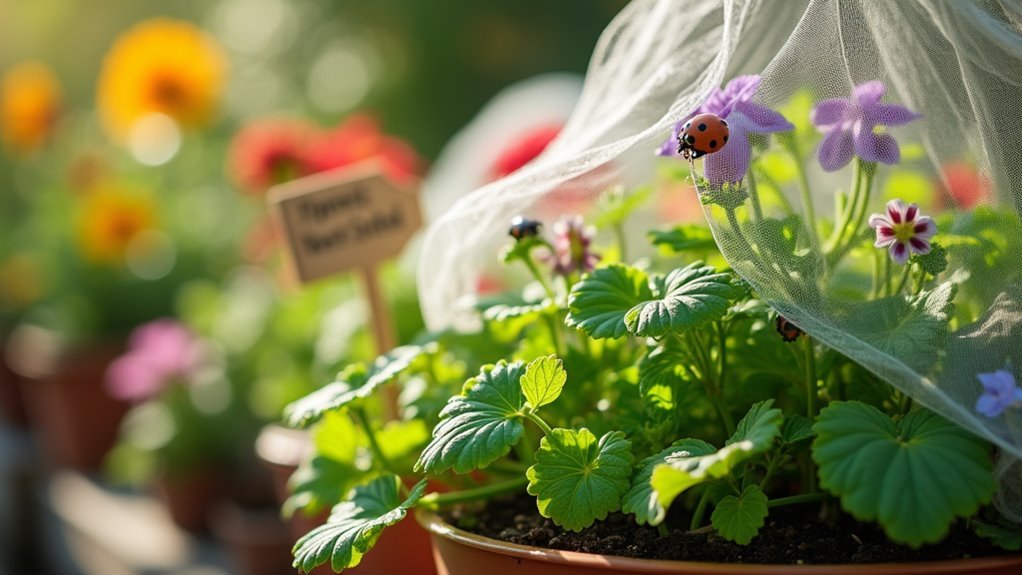
When you’re setting up your container garden, pests can infiltrate your plants from several unexpected sources before you even notice a problem.
Nursery pots often harbor hidden pest infestations that transfer directly to your containers. You’ll unwittingly invite trouble when reusing old potting soil or garden soil, as these materials frequently contain insect eggs and larvae waiting to hatch.
That innocent-looking nursery plant could be carrying a hidden army of pests ready to colonize your entire container garden.
Your kitchen habits also matter—infected fruits and vegetables can easily spread pests to nearby container plants.
Outdoor insects naturally seek your containers for food and shelter, making invasion inevitable without proper precautions.
Don’t overlook previously used containers either, since they may retain pest remnants from earlier plantings.
Understanding these common entry points helps you identify vulnerabilities and take proactive steps to protect your container garden investment.
Physical Barrier Methods for Pest Prevention
Since prevention beats treatment every time, physical barriers offer your most reliable defense against container garden invaders.
These physical barrier methods for pest prevention create impenetrable shields that protect your plants without chemicals.
Install two to three-foot fences to block rabbits, while deer require six to eight-foot barriers around your container gardening setup.
Cover young plants with fine netting or row covers that allow sunlight and moisture through while keeping birds and insects out.
Wrap collars around plant bases to stop cutworms from destroying seedlings.
Reflective mulches repel whiteflies by creating uncomfortable environments they’ll avoid.
Elevate your containers or use raised beds – this improves drainage while making it harder for ground-dwelling pests like rabbits to reach your plants.
Natural Repellent Strategies Using Essential Oils and Herbs
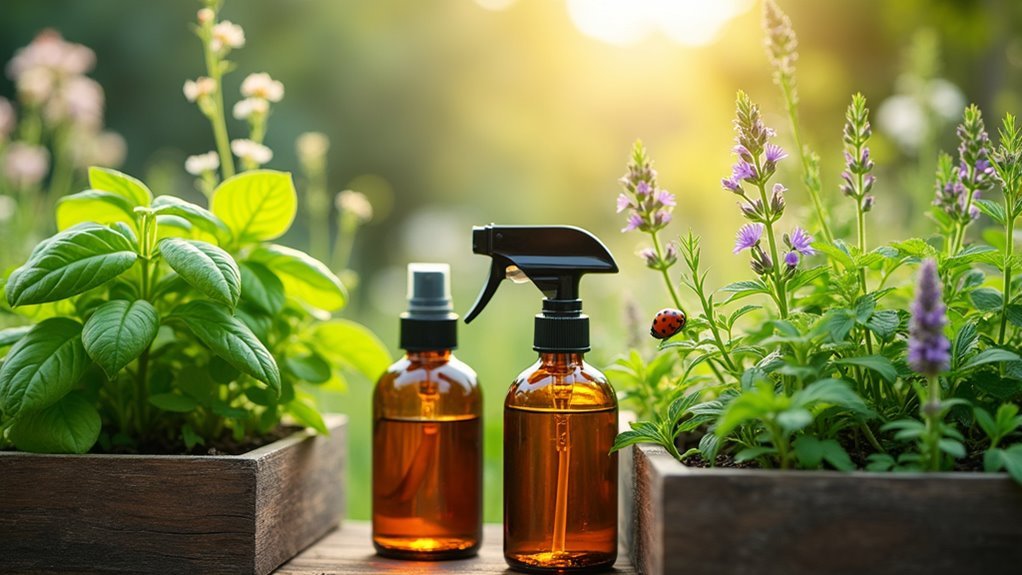
While physical barriers provide excellent protection, you’ll find that natural repellents offer an equally powerful yet gentler approach to pest control.
Essential oils like peppermint and clove create strong scents that effectively deter insects from your container gardens. You can easily make homemade deterrents by mixing these herb oils with water and mild soap for a non-toxic solution.
Hot pepper spray proves another excellent option – simply blend hot peppers with water and apply regularly to repel various pests safely.
You’ll also benefit from planting aromatic herbs like basil and rosemary directly in your containers, as they naturally ward off unwanted insects while enhancing your plants’ flavor and health, creating a thriving garden ecosystem.
Creating Homemade Pest Control Sprays and Solutions
You can create powerful pest control solutions by mixing essential oils with simple household ingredients for maximum effectiveness.
Start with peppermint or clove oil recipes that combine 10-15 drops of your chosen oil with one liter of water and a few drops of dish soap to create a potent repellent spray.
Store these homemade solutions in dark, cool locations and apply them every 3-5 days to maintain their pest-deterring properties in your container garden.
Essential Oil Recipes
Five powerful essential oil recipes can transform your kitchen pantry into a pest control arsenal for your container garden.
These essential oil recipes offer natural alternatives to harsh chemicals while effectively deterring unwanted insects.
Mix peppermint or clove essential oils with water and mild soap to create versatile pest deterrent sprays.
For stronger protection, blend neem oil—one teaspoon per liter of water plus dish soap—to disrupt insect life cycles and create a potent non-toxic insecticide.
Garlic spray works exceptionally well: blend two cloves with one liter of water, let sit overnight, strain, and add dish soap.
Hot pepper spray follows similar preparation—blend peppers with water, steep overnight, then strain.
These pest control methods require weekly reapplication, especially after rain or watering, to maintain effectiveness.
Application and Storage
Once you’ve selected your preferred essential oil recipe, proper application and storage techniques guarantee maximum effectiveness against container garden pests.
Apply your homemade sprays every 7–14 days to maintain consistent pest control. Spray during early morning or evening hours to prevent leaf burn and maximize absorption. Cover all plant surfaces thoroughly, including undersides of leaves where pests often hide.
For storage, keep your homemade solutions in a cool, dark place away from direct sunlight. Label each container clearly with contents and preparation date. Use your pest control sprays within a few weeks for maximum potency, as natural ingredients lose effectiveness over time.
Shake well before each application since oil and water naturally separate. Store spray bottles in areas inaccessible to children and pets for safety.
Companion Planting Techniques for Natural Pest Deterrence
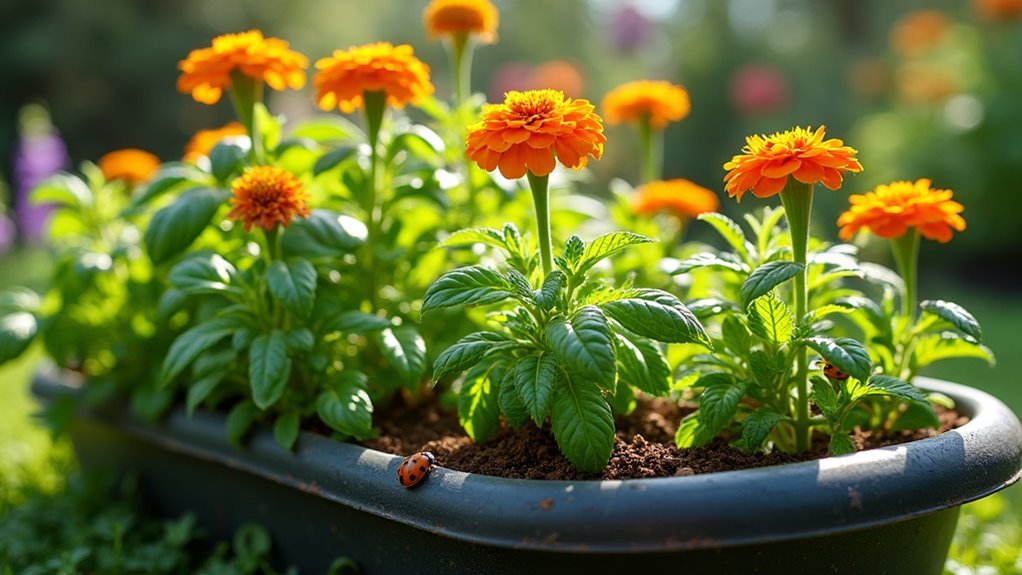
You can harness the power of plant partnerships to create a natural defense system that repels pests while boosting your container garden’s health.
Strategic companion combinations like basil with tomatoes or marigolds with vegetables work through chemical interactions that deter harmful insects and attract beneficial ones.
Implementing these techniques requires understanding which plants complement each other and how to arrange them effectively within your limited container space.
Plant Partnership Benefits
While chemical pesticides offer quick fixes, companion planting creates a natural defense system that protects your container garden through strategic plant partnerships.
You’ll discover that certain plants work together like nature’s own security team, enhancing each other’s growth while repelling harmful pests and attracting beneficial insects.
These powerful plant partnerships deliver remarkable results:
- Marigolds release compounds that create an invisible barrier against nematodes and soil-dwelling pests.
- Basil’s aromatic oils form a protective shield around tomatoes, keeping mosquitoes and flies at bay.
- Nasturtiums act as sacrificial guardians, drawing aphids away from your precious vegetables.
- Dill’s delicate flowers beckon parasitic wasps that hunt down pest populations.
- Fennel’s umbrella blooms create landing pads for pollinators and pest-controlling insects.
You’re building an ecosystem that works around the clock.
Strategic Companion Combinations
Success in companion planting hinges on selecting the right plant partnerships for your specific container setup and pest challenges. You’ll maximize protection by strategically pairing plants that complement each other’s natural pest-fighting abilities.
| Primary Plant | Companion Plant | Pest Control Benefit |
|---|---|---|
| Tomatoes | Basil | Repels mosquitoes and flies |
| Roses | Garlic | Deters aphids effectively |
| Vegetables | Marigolds | Controls nematodes and various pests |
| Any crops | Dill | Attracts beneficial ladybugs |
| Garden plants | Fennel | Draws in pest-eating lacewings |
Focus on combining plants with complementary growing requirements and pest-fighting properties. Place marigolds throughout vegetable containers, position basil near tomatoes, and scatter garlic around rose plantings. This companion planting approach creates a natural defense system that’s both effective and sustainable.
Implementation Best Practices
Since effective companion planting requires careful placement and timing, start by positioning your strongest aromatic herbs like basil and mint at the edges of containers where their scent can create a protective barrier around more vulnerable plants.
- Center your tomatoes with marigolds circling the perimeter to release nematode-deterring compounds into the soil.
- Plant nasturtiums as sacrificial guardians that’ll lure aphids away from your prized vegetables.
- Scatter borage flowers throughout containers to attract beneficial predatory wasps that hunt garden pests.
- Layer mint strategically near container openings where its intense fragrance masks vegetable scents from approaching insects.
- Rotate companion combinations each growing season to disrupt established pest life cycles and maintain garden biodiversity.
You’ll maximize companion planting effectiveness by timing plantings so aromatic herbs establish before pests typically arrive, creating an established defense system.
Beneficial Insects as Biological Pest Control Agents
When you harness the power of beneficial insects in your container garden, you’re enlisting nature’s most effective pest control team.
Ladybugs consume up to 50 aphids daily, while lacewings prey on various harmful insects including caterpillars. Parasitic wasps take a different approach, laying eggs directly in or on caterpillars to control pest populations naturally.
To attract these beneficial insects, plant diverse flowers and herbs that provide essential habitats and food sources throughout the growing season.
Don’t forget about earthworms—they’ll aerate and fertilize your soil, creating robust plant growth that’s naturally more resistant to pests.
Minimize pesticide use and opt for botanical insecticides when necessary. This approach preserves beneficial insect populations, allowing them to thrive and effectively manage your container garden’s pest issues.
Proper Container Setup to Minimize Pest Attraction
While beneficial insects provide excellent pest control, your container setup itself serves as your first line of defense against unwanted invaders.
Smart preparation prevents garden pests from establishing themselves in your container garden before they become problematic.
Essential setup practices include:
- Clean containers – Select unused or thoroughly sanitized pots to eliminate pest hitchhikers lurking in crevices
- Proper drainage – Install adequate holes to prevent waterlogged soil that attracts fungus gnats and causes root rot
- Fresh potting soil – Use sterile growing medium instead of reused soil harboring dormant pests and pathogens
- Elevated positioning – Raise containers on stands to block slugs and snails from crawling up
- Diatomaceous earth barrier – Sprinkle food-grade powder on soil surfaces to deter crawling insects
These proactive measures create an inhospitable environment for pests while supporting healthy plant growth.
Soil Management and Drainage for Pest Prevention
Beyond initial setup, your soil composition and moisture management directly impact pest populations in container gardens.
Start with fresh, sterile potting soil rather than reused or garden soil to prevent introducing existing pests. Confirm your containers have adequate drainage holes to prevent waterlogging, which attracts fungus gnats and causes root rot.
Check regularly for soil compaction and aerate when needed to maintain healthy roots and create an environment that’s less appealing to pests. Incorporate organic compost to improve soil structure and drainage capabilities.
Apply mulch to cover exposed soil surfaces, creating a protective barrier against pests while maintaining ideal moisture and temperature levels.
Effective soil management creates conditions where plants thrive and pests struggle to establish themselves.
Plant Selection for Pest-Resistant Container Gardens
You’ll dramatically reduce pest problems by choosing the right plants from the start.
Climate-adapted varieties that thrive in your local conditions naturally resist regional pests and diseases, while certain species actively repel unwanted insects through their inherent characteristics.
Strategic plant selection transforms your container garden into a fortress that pests find uninviting and difficult to colonize.
Climate-Adapted Plant Varieties
The foundation of a thriving, pest-resistant container garden starts with selecting plants that have naturally evolved to handle your local environment’s challenges.
Climate-adapted plant varieties possess inherent defenses that make them less susceptible to regional pest problems.
When you choose native species, you’re selecting plants that have co-evolved with local insects, developing natural resistance mechanisms over centuries.
These plants understand your area’s rainfall patterns, temperature fluctuations, and soil conditions.
Consider these climate-adapted plant varieties for stronger pest resistance:
- Native wildflowers that bloom consistently despite local weather extremes
- Indigenous herbs with natural oils that repel common regional insects
- Heat-tolerant vegetables that maintain vigor during summer stress
- Cold-hardy greens that resist fungal diseases in humid conditions
- Drought-resistant succulents that avoid moisture-related pest attraction
Natural Pest-Deterrent Species
Building on climate adaptation, certain plant species actively work as living shields against garden pests through their natural chemical defenses and physical characteristics.
You’ll find that aromatic herbs like basil and rosemary effectively repel aphids and mosquitoes through their strong scents.
Plant marigolds alongside your edible crops to deter nematodes and harmful insects with their natural pest-repellent compounds.
Choose native species that’re already adapted to resist local pests and diseases, creating a more sustainable defense system.
Include fuzzy-leaved plants such as lamb’s ear, whose texture discourages many insects from landing or feeding.
Diversify your container plantings with these natural pest-deterrent species to minimize pest attraction while supporting beneficial insects that maintain ecological balance.
Regular Monitoring and Early Detection Practices
Since pest populations can double within days, establishing a consistent monitoring routine becomes your most powerful defense against infestations in container gardens.
A consistent monitoring routine serves as your most powerful defense against rapidly multiplying pest populations in container gardens.
Regular monitoring involves weekly inspections that’ll help you catch problems before they spiral out of control.
Focus on these key detection strategies:
- Examine leaves thoroughly – Look for telltale holes, unusual discoloration, or tiny specks of frass that indicate pest activity.
- Check soil surfaces – Inspect around plant bases for signs of crawling insects or larvae.
- Place sticky traps strategically – Position yellow cards near susceptible plants to catch flying pests early.
- Document findings systematically – Keep a gardening journal tracking pest sightings and plant health changes.
- Inspect plant stems – Search for egg clusters, webbing, or unusual growths that signal infestations.
This proactive approach enables quick intervention when issues arise.
Organic Treatment Options for Active Infestations
When pests have already established themselves in your container garden, you’ll need swift organic interventions to regain control.
You can deploy natural spray solutions like neem oil and insecticidal soaps to target active infestations directly on affected plants.
Additionally, you’ll want to contemplate releasing beneficial insects and applying soil treatment methods to address pests at multiple life stages and locations.
Natural Spray Solutions
Although chemical pesticides offer quick results, natural spray solutions provide safer alternatives that won’t harm beneficial insects or contaminate your edible plants.
These homemade remedies effectively target common container garden pests while protecting your family and environment.
You can create powerful natural spray solutions using common household ingredients:
- Neem oil mixture – Blend with water and mild dish soap, applying every 7–14 days to disrupt pest life cycles
- Garlic spray – Blend garlic cloves with water, strain, add dish soap for weekly aphid and whitefly control
- Insecticidal soap – Apply directly to suffocate soft-bodied insects safely
- Hot pepper spray – Mix crushed peppers with water for broad-spectrum pest deterrence
- Essential oil blends – Use peppermint or clove oils with consistent reapplication for lasting protection
Beneficial Insect Release
While natural sprays address mild pest problems, beneficial insect release provides a powerful biological solution for active infestations that threaten your container garden’s health.
You’ll want to deploy ladybugs, lacewings, and parasitic wasps as your organic army against destructive pests.
Release beneficial insects during evening hours or on overcast days to protect them from predators and help them establish successfully. A single ladybug consumes up to 50 aphids daily, while parasitic wasps eliminate caterpillars by laying eggs inside them. Lacewings target various soft-bodied pests effectively.
Plant diverse flowering species around your containers to attract and sustain these helpful predators naturally. This creates a balanced ecosystem where beneficial insects thrive year-round, providing ongoing pest control without chemical intervention for your garden.
Soil Treatment Methods
Beyond releasing beneficial insects, you can target pest infestations directly through strategic soil treatment methods that create an inhospitable environment for harmful organisms.
These organic approaches transform your potting soil into a protective barrier while maintaining plant health.
Effective soil treatment methods include:
- Beneficial nematode application – Release microscopic worms that hunt grubs and larval pests without harming beneficial organisms.
- Diatomaceous earth barrier – Sprinkle DE to dehydrate slugs and beetles through physical contact.
- Organic compost enrichment – Build beneficial microbial communities that outcompete harmful pest populations.
- Neem cake incorporation – Disrupt aphid and whitefly life cycles with natural insecticidal compounds.
- Seasonal soil rotation – Replace potting soil between growing seasons to prevent pest buildup.
Seasonal Pest Prevention Maintenance Schedules
Since container gardens face different pest pressures throughout the year, you’ll need a strategic maintenance schedule that adapts to each season’s unique challenges. Effective seasonal pest prevention maintenance schedules require consistent monitoring and proactive care.
| Season | Key Tasks | Prevention Focus |
|---|---|---|
| Spring | Inspect plants for pest signs, clean pots and tools thoroughly | Eliminate overwintering pest eggs and larvae |
| Summer | Monitor plant health regularly, apply neem oil or insecticidal soap | Manage emerging infestations promptly |
| Fall | Remove dead foliage and debris, install protective coverings | Prevent pest harborage sites |
| Year-round | Check soil moisture and nutrient levels consistently | Maintain plant resilience against attacks |
You’ll find that maintaining this routine throughout the growing season keeps your container plants healthy and naturally resistant to pest problems.
Crop Rotation Strategies in Container Gardening
Although container gardens occupy fixed spaces, you can still implement effective crop rotation by strategically moving different plant families between containers each season.
Strategic container rotation between plant families each season maximizes garden health despite limited physical space constraints.
These crop rotation strategies disrupt pest life cycles that specialize in specific crops, preventing harmful accumulations.
Here’s how to maximize your rotation effectiveness:
- Swap containers between tomatoes, peppers, and eggplants to confuse pests targeting nightshade families
- Replace potting soil completely each season to eliminate overwintering pests and diseases
- Add fresh organic compost during rotation to boost soil fertility and plant resilience
- Track pest patterns in a garden journal to inform future rotation decisions
- Monitor plant health regularly for early pest detection and rotation adjustments
You’ll create a dynamic defense system that keeps pests guessing while maintaining healthy, productive container gardens.
Long-Term Garden Health for Natural Pest Resistance
When you focus on building long-term garden health, you’re creating the foundation for plants that naturally resist pests without constant intervention.
Healthy soil enriched with organic compost strengthens plant resilience, making them less appealing targets for pests and diseases. You’ll prevent long-term damage by implementing crop rotation in your containers, which stops pest populations from establishing themselves in the soil.
Regular monitoring helps you catch problems early before they escalate into serious infestations.
Companion planting naturally deters harmful insects while boosting your primary crops’ growth through beneficial relationships. Introducing beneficial insects like ladybugs and lacewings creates a balanced ecosystem that maintains pest resistance over time.
These strategies work together, building a self-sustaining garden that thrives with minimal chemical intervention.
Frequently Asked Questions
How Do I Protect My Container Garden From Animals?
You’ll need different fence heights depending on animals—two to three feet for rabbits, six to eight feet for deer. Elevate containers two feet high and use chicken wire underground to prevent burrowing pests.
How to Keep Pests Out of Potted Plants?
Use fresh sterile potting soil and elevate your containers on stands. Inspect plants regularly for early pest detection. Apply diatomaceous earth around plant bases and spray with natural repellents like neem oil.
What Is the Best Deterrent for Garden Pests?
You’ll find neem oil is the most effective deterrent since it disrupts insect life cycles and works against multiple pests like aphids and spider mites when you apply it consistently every seven to fourteen days.
What Is the Best Method of Protecting Plants From Pests?
You’ll achieve best results by combining multiple approaches: inspect plants regularly for early detection, use non-toxic treatments like neem oil, install physical barriers, and choose pest-resistant varieties with companion planting.
In Summary
You’ve got the tools to protect your container garden naturally and effectively. By combining physical barriers, natural repellents, companion planting, and organic treatments, you’ll create a thriving pest-resistant environment. Don’t forget to maintain seasonal schedules and rotate your crops regularly. With consistent application of these strategies, you’ll enjoy healthy plants and bountiful harvests while keeping harmful pests at bay without relying on chemical solutions.

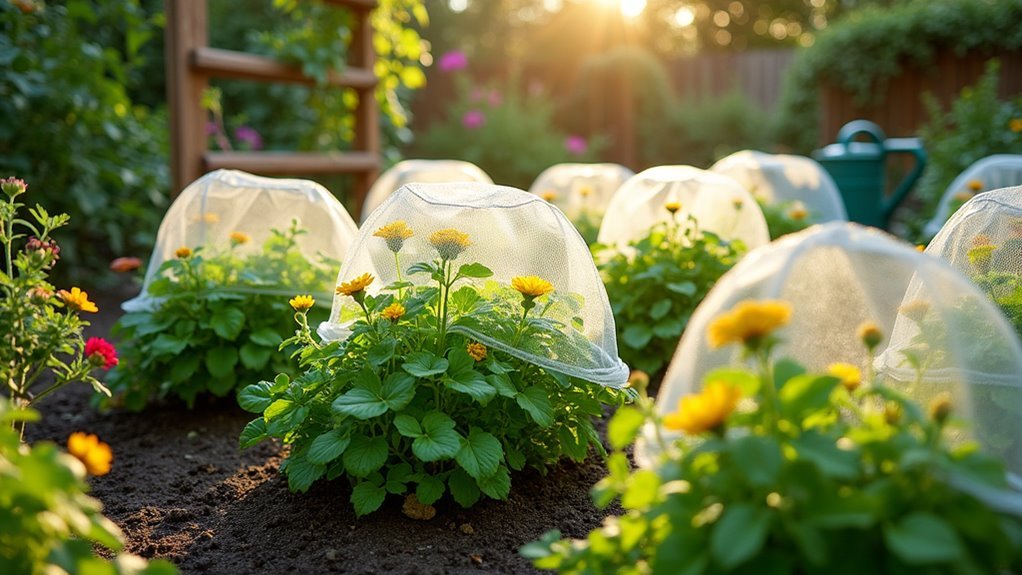
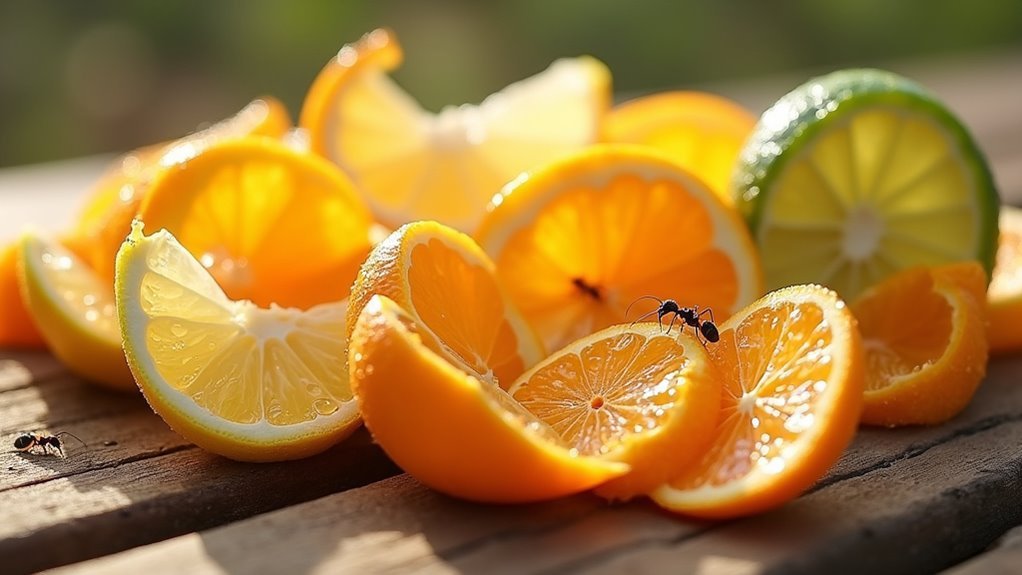

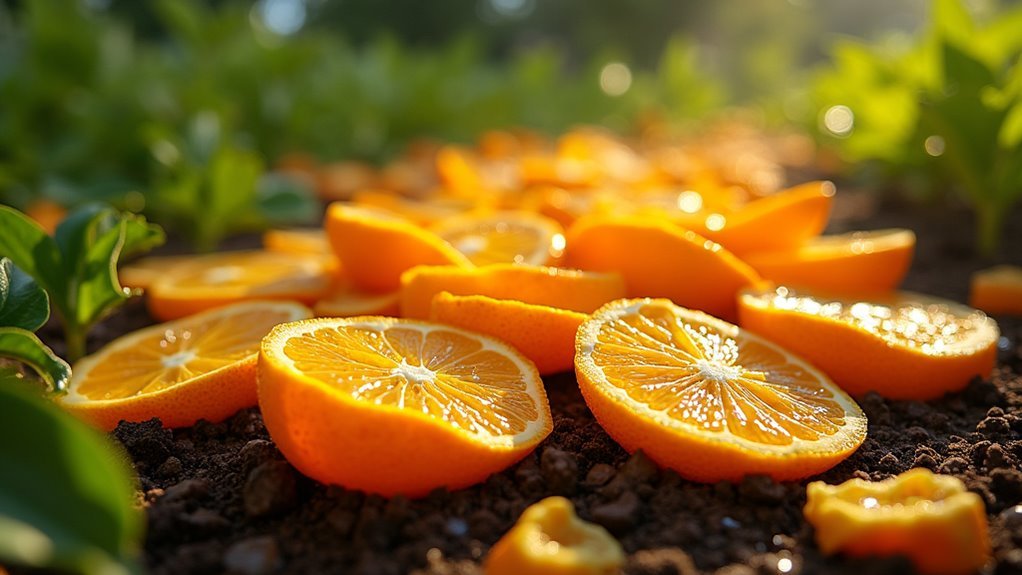
Leave a Reply